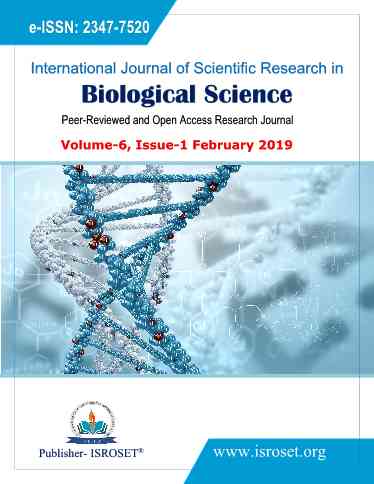Impact of fertilizer urea on liver histopathology of fresh water snake head, Channa punctata
Keywords:
Channa punctata, fish, histopathology, liver, ureaAbstract
The widespread use of agrochemicals such as fertilizers in agricultural practices have been predicted to show adverse effects on fish, since bulk of the fertilizers sprayed on agricultural crops find way into water bodies. The effect of commonly used fertilizer, urea on histopathology of fresh water teleost fish Channa punctata was studied. The median lethal concentration after exposing fish to urea for 96 hours (96-h LC50) was found to be 19.75 gL-1 and for the chronic toxicity tests spanning for 28 days, sublethal concentrations of urea, viz., 1.97 g L−1 (1/10th 96-h LC50) and 9.87 g L−1 (1/2 of 96-h LC50) were considered. Accordingly, two test groups having 3 replicates with 5 fish in each one were exposed to 1.97 g L−1 and 9.87 g L−1 urea. Control in tap water without urea was simultaneously run. After 28 days of chronic exposure fish liver samples were collected, processed, stained in Hematoxylin-Eosin and observed under light microscope for histopathological alterations. The liver of control group were normal while the fish exposed to urea showed signs of hepatic alterations such as dilation of sinusoids, vacuolation and necrosis, with severity increasing with dose. This study revealed that urea, which seems innocuous, could actually induce various histopathological anomalies in fish, posing a threat to ecosystem.
References
D. Despommier, “The rise of vertical farms” Sci. Am. Vol. 301, pp. 60–67. 2009.
J.J. Stegeman, M.E. Hahn, Biochemistry and molecular biology of monooxygenase: current perspective on forms, functions, and regulation of cytochrome P450 in aquatic species. In: Malins, D.C., Ostrander, G.K. (Eds.), Aquatic toxicology; Molecular, Biochemical and Cellular Perspectives. Lewis Publishers, CRC press, Boca Raton, pp. 87-206. 1994.
I. Altinok, E. Capkin, “Histopathology of rainbow trout exposed to sublethal concentrations of methiocarb or endosulfan”, Toxicol. Pathol. Vol. 35, pp. 405–410. 2007.
P.M. Glibert, J. Harrison, C. Heil, S. Seitzinger, “Escalating worldwide use of urea—a global change contributing to coastal eutrophication. Biogeochemistry,” Vol. 77, pp. 441–463. 2006.
V. Palanivelu, K. Vijayavel, S. Ezhilarasibalasubramanian, M.P. Balasubramanian, “Impact of fertilizer (urea) on oxygen consumption and feeding energetic in the fresh water fish Oreochromis mossambicus,” Environ. Toxicol. Pharmacol. Vol.19, pp. 351–355. 2005.
NRC: Committee on Biological Markers of the National Research Council, Biological markers in environmental health research. Environ. Health Perspect. Vol. 74, pp. 3-9. 1987.
R.J. Roberts, Fish Pathology. W.B. Saunders, Philadelphia. 2001.
I. Riba, J.Blasco, N. Jime´nez-Tenorio, M.L. Gonza´ lez de Canales,T. Angel DelValls, “Heavy metal bioavailability and effects: II. Histopathology–bioaccumulation relationships caused by mining activities in the Gulf of Cadiz (SW,Spain)”, Chemosphere, Vol.58, pp. 671–682. 2005.
D. Finney, Probit analysis, pp. 333. 1971.
OECD (Organization for Economic Cooperation and Development), Guideline For The Testing of Chemicals: Fish, Acute Toxicity Test, No. 203. 1992.
S. Das, A. Gupta, “Effects of cadmium chloride on oxygen consumption and gill morphology of Indian flying barb, Esomus danricus.” J environ boil, Vol. 33, 1057-1061. 2012.
E. Bulut, A. Aksoy, “Impact of fertilizer usage on phosphorus loads to Lake Uluabat. Desalination,” Vol. 226, pp. 289 – 297. 2008.
A.C. Benli, G. Koksal, A. Ozkul, “Sublethal ammonia exposure of Nile tilapia (Oreochromis niloticus L.): effects on gill, liver and kidney histology,” Chemosphere, Vol. 72, pp. 1355-1358. 2008.
R.T. Di Giulio, D.E. Hinton, The Toxicology of Fishes. CRC Press Taylor & Francis Group, London, pp. 370–380. 2008.
E. Agamy, “Histopathological liver alterations in juvenile rabbit fish (Siganus canaliculatus) exposed to light Arabian crude oil, dispersed oil and dispersant,” Ecotoxicol. Environ. Saf. Vol. 75, pp. 171 – 179. 2012.
J. Kiesecker, “Synergism between trematode infection and pesticide exposure: a link to amphibian limb deformities in nature,” Proc Natl Acad Sci USA, Vol. 99, pp. 9900–9904. 2002.
L.J. Binkowski, K. Sawicka-Kapusta, J. Szarek, E. Strzy żewska, M. Felsmann, “Histopathology of liver and kidneys of wild living Mallards Anas platyrhynchos and Coots Fulica atra with considerable concentrations of lead and cadmium,” Sci. Total Environ., Vol. 450 – 451, pp. 326 – 333. 2013.
Y. Archana, G. Anita, S. P Ravi, K. R. Devendra, S. Bechan, “Fertilizer Industry Effluent Induced Biochemical Changes in Fresh water Teleost, Channa striatus (Bloch).” Bull Environ Contam Toxicol. Vol. 79, pp. 588–595. 2007.
W.B. Ameur, J. de Lapuente, Y.EI. Megdiche, B. Barhoumi, S. Trabelsi, L. Camps, J. Serret, D. Ramos-L, J. Gonzalez-Linares, M.R. Driss, M. Borràs, “Oxidative stress, genotoxicity and histopathology biomarker responses in mullet (Mugil cephalus) and sea bass (Dicentrarchus labrax) liver from Bizerte Lagoon (Tunisia),” Mar. Pollut. Bull.Vol. 64, pp. 241–251. 2012.
H. Liu, P. Sun, H. Liu, S. Yang, L. Wang, Z. Wang, “Hepatic oxidative stress biomarker responses in freshwater fish Carassius auratus exposed to four benzophenone UV filters,” Ecotox Environ Safe, Vol. 119, pp. 116-122. 2015.
F.A. Guardiola, A. Cuesta, J. Meseguer, S. Martinez, M.J. Martinez-Sanchez, C. PerezSirvent, M.A. Esteban, “Accumulation, histopathology and immunotoxicological effects of waterborne cadmium on gilthead seabream (Sparus aurata),” Fish Shellfish Immun. Vol. 35, 792–800. 2013.
Downloads
Published
How to Cite
Issue
Section
License

This work is licensed under a Creative Commons Attribution 4.0 International License.
Authors contributing to this journal agree to publish their articles under the Creative Commons Attribution 4.0 International License, allowing third parties to share their work (copy, distribute, transmit) and to adapt it, under the condition that the authors are given credit and that in the event of reuse or distribution, the terms of this license are made clear.







